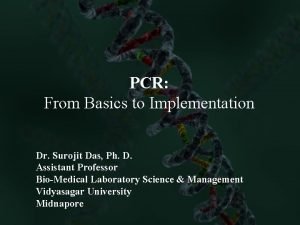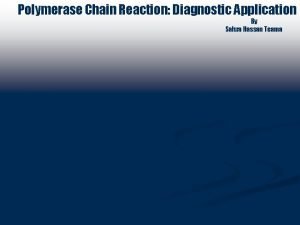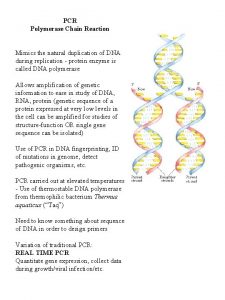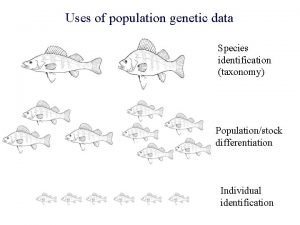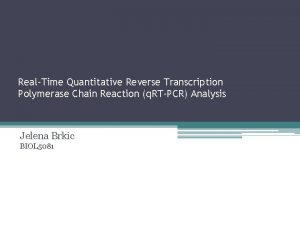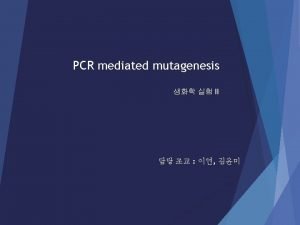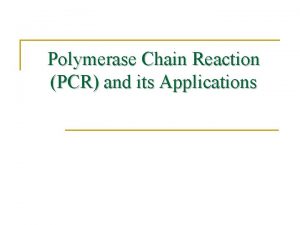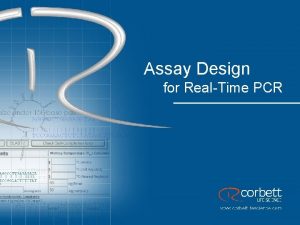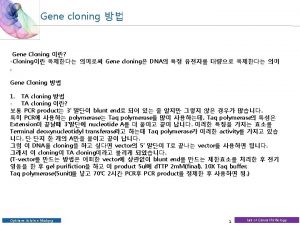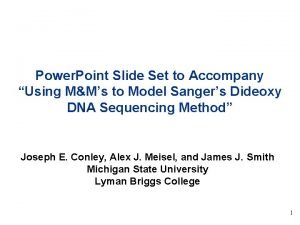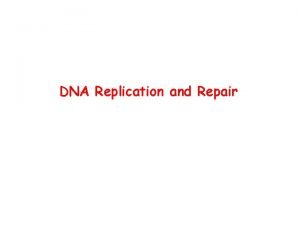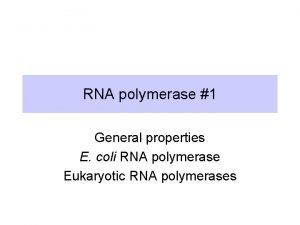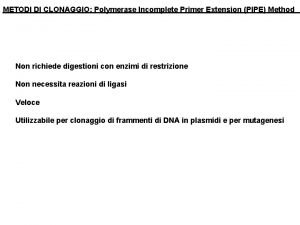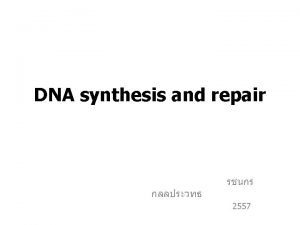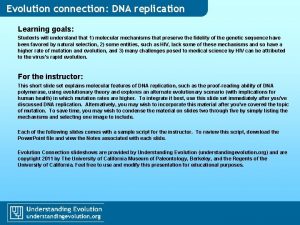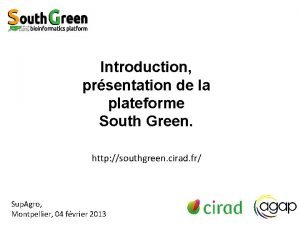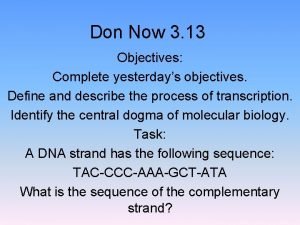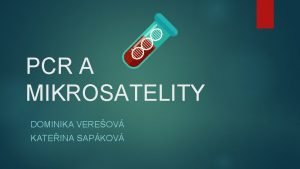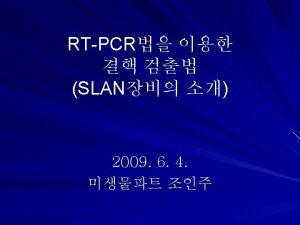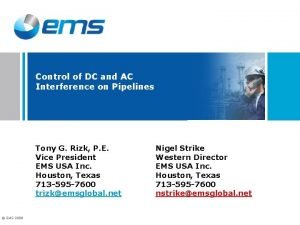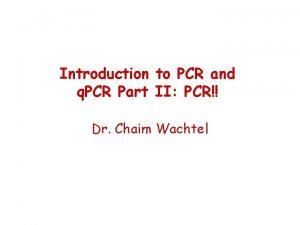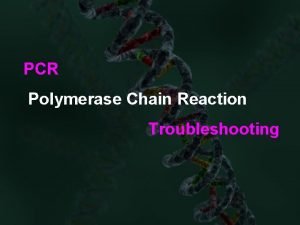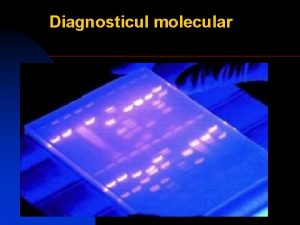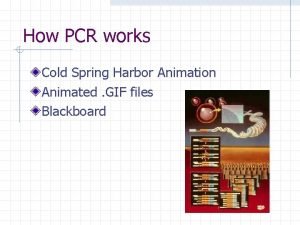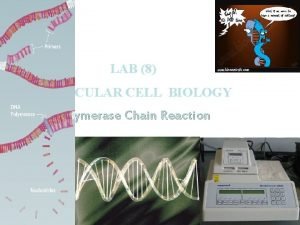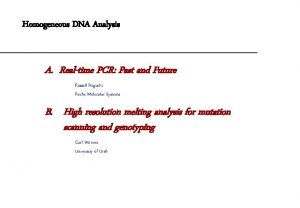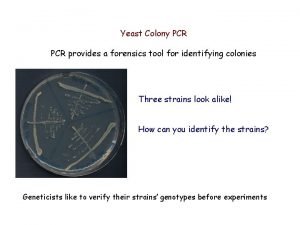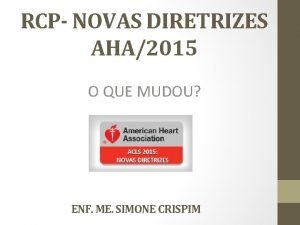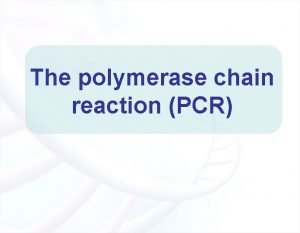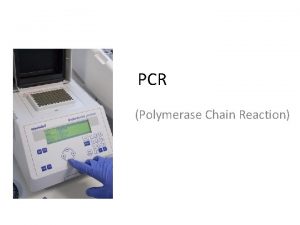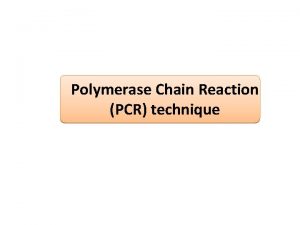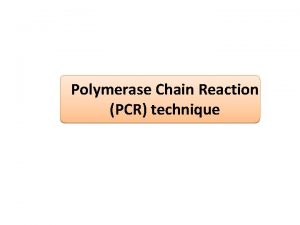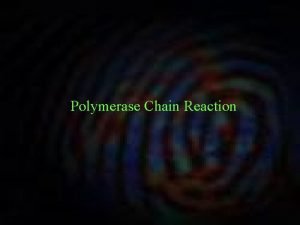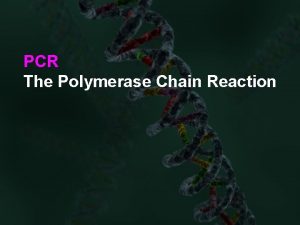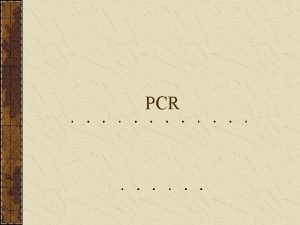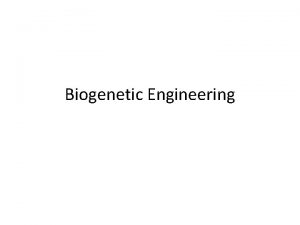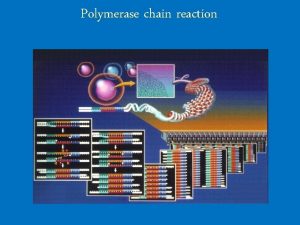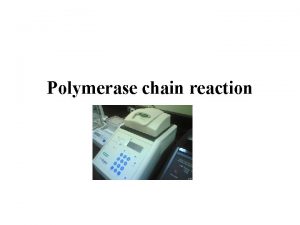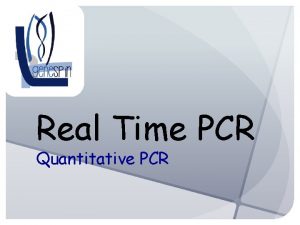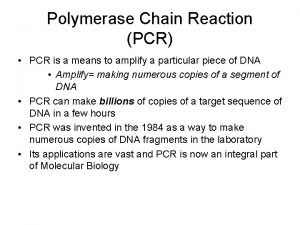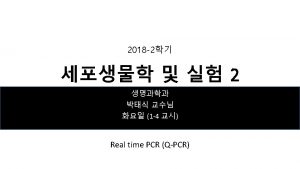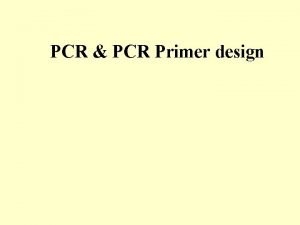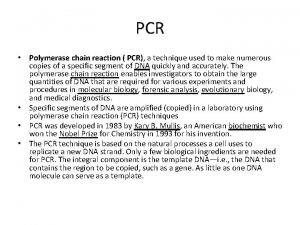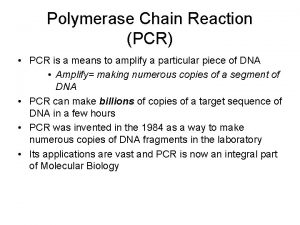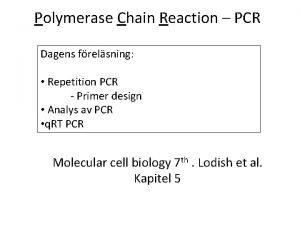Polymerase Chain Reaction PCR Polymerase chain reaction Starting













































- Slides: 45

Polymerase Chain Reaction (PCR) • Polymerase chain reaction: Starting with VERY SMALL AMOUNTS OF DNA (sometimes a few molecules), one can amplify the DNA enough to detect it by electrophoresis.

5’ 3’ 3’ 5’ Denaturation 5’ 3’ 3’ 5’ Annealing 5’ 3’ 3’ 5’ 5’ 5’ 3’ 3’ 5’ 3’ Cycle 1 5’ 3’ 3’ Extension 5’ 3’ Cycle 2 5’ 3’ 5’ 3’ 3’ Cycle 3 3’ 3’ 5’

• Rate of PCR 2 n Initial DNA 1 2 4 Number of DNA molecules 8

Copies of DNA=2 N

RT-PCR • Polymerase chain reaction amplification of c. DNA can also be used to detect specific transcripts in a RNA sample. • In this procedure, known as RT-PCR, reverse transcriptase is used to copy all of the m. RNAs in an RNA sample into c. DNA. • Usually, oligo d. T molecules, that anneal to the poly A tails of the m. RNA, are used as primers. • This single stranded c. DNA can then be amplified by PCR using primers that anneal to a specific transcript sequence.

RT-PCR 5‘-Cap m. RNA (d. T)12~18 primer AAA(A)n anneal 3‘ 5‘ AAA(A)n d. NTP Reverse transcriptase 5‘ c. DNA: m. RNA hybrid AAA(A)n Regular PCR

• The amplified DNA fragments that are produced can by analyzed by agarose gel electrophoresis. • The amount of amplified fragment produced is proportional to the amount of target m. RNA in the original RNA sample. • Although less quantitative than Northern blots, RT-PCR is extremely sensitive and can be used to detect very rare m. RNA species.


How do we accurately quantify the amount of DNA? Real-time PCR

Real Time PCR

3. intensifier 1. halogen tungsten lamp 2 b. emission filters 2 a. excitation filters 4. sample plate 5. ccd detector 350, 000 pixels

Amplification Plot of real-time PCR DNA copy number (log) Log phase Level off/ plateau 2 4 8 16 32 PCR cycle (Ct)

DNA sequencing • Sequencing is used to determine the precise order of nucleotides in a DNA molecule. • The Sanger di-deoxy method involves the synthesis of DNA by a DNA polymerase. • DNA synthesis is terminated at specific nucleotides by the incorporation of di-deoxy nucleotides that are missing the 3’ OH.










Sequence analysis • Four different reactions produce DNA fragments that are terminated (randomly) at each of the four nucleotides. • These samples are resolved by electrophoresis. • The shortest fragments, those terminated closest to the primer, run faster than the longer fragments.


ACGT • DNA sequencing reactions can be radioactively labeled. • Bands detected by Xray film exposure. • Sequence can be read in the 5’ to 3’ direction from the bottom of the image towards the top. A A T C T A A C G

This is great but… Wouldn’t it be great to run everything in one lane? Saves space and time, more efficient Fluorescently label the dd. NTPs so that they each have a different color…

07_03. jpg

• Automated DNA sequencers use dideoxy terminators labeled with four different fluorescent dyes. • All four reactions can be carried out simultaneously in a single reaction.

• Fluorescently tagged fragments are resolved by capillary electrophoresis and detected by a flourometer. • The DNA sequence is read automatically.

Beckman CEQ 2000, 8 capillary ABI Prism 3730, 96 capillary

Affymetrix Gene Chip

Affymetrix Expression Arrays http: //www. affymetrix. com/technology/ge_analysis/index. affx



Analysis of microarrays • Microarrays allow for the simultaneous analysis of the expression of thousands of m. RNAs. • Useful for determining changes in gene expression patterns from one sample tissue to another. • For example, microarrays have been used to study differences in gene expression in different tumor tissues.

Genes with similar expression patterns are clustered together. Gene expression patterns can be associated with different disease patterns.

Microarray example #1: Biomarker identific - lung cancer G e ne s Samples Garber, Troyanskaya et al. Diversity of gene expression in adenocarcinoma of the lung. PNAS 2001, 98(24): 13784 -9.

Data partitioning clinically important: Patient survival for lung cancer subgroups 1 Cum. Survival (Group 1) Cum. Survival (Group 2) Cum. Survival . 8 Cum. Survival (Group 3). 6 p = 0. 002 for Gr. 1 vs. Gr. 3 . 4 . 2 0 0 10 20 30 40 50 60 Time (months) Garber, Troyanskaya et al. Diversity of gene expression in adenocarcinoma of the lung. PNAS 2001, 98(24): 13784 -9.

Another microarray example: understanding malaria IDC Transcriptomes for three P. falciparum strains Llinas, M. et al. Nucl. Acids Res. 2006 34: 1166 -1173; doi: 10. 1093/nar/gkj 517

Yeast 2 Hybrid Allows the genetic detection of physical interactions between proteins

Yeast Two Hybrid Assay • • The two-hybrid system is a molecular genetic tool which facilitates the study of protein-protein interactions. If two proteins interact, then a reporter gene is transcriptionally activated. – e. g. gal 1 -lac. Z - the beta-galactosidase gene • • A colour reaction can be seen on specific media. You can use this to – Study the interaction between two proteins which you expect to interact – Find proteins (prey) which interact with a protein you have already (bait).

GAL 4 has two domains: one binds DNA (UAS) , the other activates transcription { GAL 1 UAS { { GAL 4 DNA-binding Activating GAL 1 POL .

If protein X and Protein Y interact, they lead to expression of the reporter gene.

Two-hybrid assay SNF 4 SNF 1 1. B A 2. GAL 4 -DBD 3. Transcription activation domain UASG Fields S. Song O. Nature. 1989 Jul 20; 340(6230): 245 -6. PMID: 2547163 4. GAL 1 Allows growth on galactose

Two-Hybrid Selection UAS-Reporter GAL 4 -dbd/BAIT GAL 4 -ad/X Library No expression UAS-Reporter GAL 4 -dbd/BAIT GAL 4 -ad/X Expression
 Application pcr
Application pcr Pcr
Pcr Polymerase chain reaction
Polymerase chain reaction Polymerase chain reaction
Polymerase chain reaction Polymerase chain reaction
Polymerase chain reaction The three steps of polymerase chain reaction
The three steps of polymerase chain reaction Polymerase chain reaction application
Polymerase chain reaction application Starting substances in a chemical reaction
Starting substances in a chemical reaction Sequence of food chain
Sequence of food chain Rt pcr primer efficiency
Rt pcr primer efficiency Dna polymerase iii
Dna polymerase iii Tth polymerase rtpcr
Tth polymerase rtpcr Dna polymerase
Dna polymerase Rna polymerase
Rna polymerase Replication fork
Replication fork Dna polymerase
Dna polymerase Rna polymerase
Rna polymerase Rna polymerase 1 2 3
Rna polymerase 1 2 3 Polymerase incomplete primer extension
Polymerase incomplete primer extension Dna polymerase proofreading
Dna polymerase proofreading What role does dna polymerase play in copying dna?
What role does dna polymerase play in copying dna? Dna polymerase
Dna polymerase Dna polymerase
Dna polymerase Adn polymérase
Adn polymérase Types of dna polymerase in eukaryotes
Types of dna polymerase in eukaryotes How many dna polymerase in eukaryotes
How many dna polymerase in eukaryotes Template strand, new strand, base pair, and dna polymerase.
Template strand, new strand, base pair, and dna polymerase. Fase plateau pcr
Fase plateau pcr Pcr wikiskripta
Pcr wikiskripta Slan real time pcr
Slan real time pcr Induced ac interference
Induced ac interference Pcr q
Pcr q Pcr product change request
Pcr product change request Pcr primeros auxilios
Pcr primeros auxilios Pcr troubleshooting multiple bands
Pcr troubleshooting multiple bands Pcr profile
Pcr profile Tail pcr principle
Tail pcr principle Reactia pcr
Reactia pcr Pcr biology definition
Pcr biology definition Pcr gif animation
Pcr gif animation Pcr technique
Pcr technique Pcr abi
Pcr abi Yeast colony pcr
Yeast colony pcr Rcp extracorpórea
Rcp extracorpórea Pcr copies
Pcr copies Pcr
Pcr
